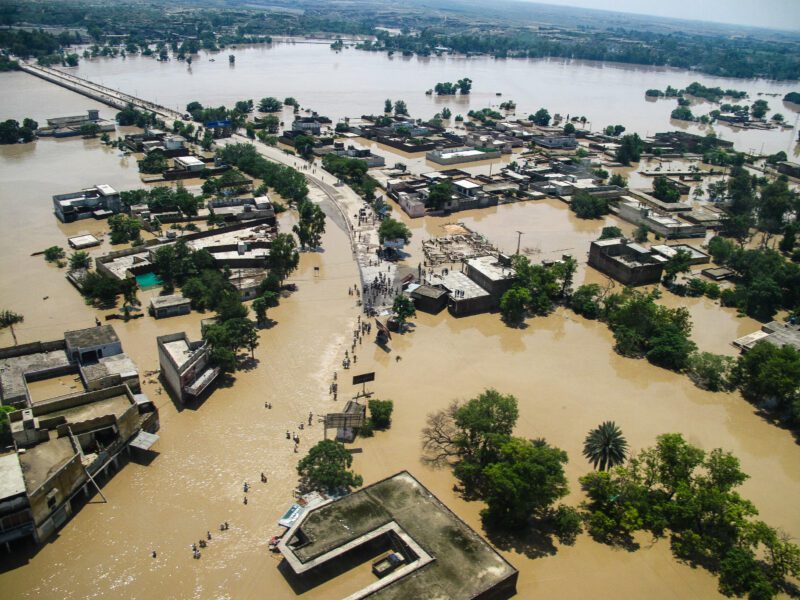By Amar Guriro and James Fahn
How does a journalist cover events on the ground when a third of a country’s land territory is flooded?
That is the dilemma that one of us – an environmental journalist with The Independent’s Urdu service – faced last year on a reporting trip in Pakistan, where unprecedented rainfall and glacial melt on the heels of a brutal heat wave led to enormous inundation.
The wrath of the flood was triggering violence between people. In Badin, we found communities battling over drainage systems. Crowds were out on the streets defending drainage canals, fearing that residents of the affluent upper districts would destroy the banks so that water would recede from their own communities – and inundate the areas below. In Tanjo Jan Muhammad, protesters blocked the main highway, demanding that the government drain flood waters from their city. A monster traffic jam that lasted for as long as five days prevented even ambulances or food suppliers from making it through.
Overall, the floods in Pakistan displaced 7.6 million people and triggered losses of up to $40 billion. Tragically, they are only one climate-related catastrophe among many.
They say that journalists write the first draft of history, and there is no bigger story in the 21st century than the climate crisis. That is why today we need environmental reporting more than ever: to document the impact of the climate crisis on ordinary people, hold those responsible to account, and lift the voices of the actors who hold a piece of the solution.
Sadly, extreme weather events are not the only danger faced by environmental journalists. Local media everywhere are struggling with failing business models and threats from vested interests, including defenders of the fossil fuel industry. In South Asia, journalists are sometimes reluctant to travel into coal-producing regions, fearing that they will be set upon.
The fossil fuel industry certainly understands the power of the press: they are prolific advertisers, and in many countries, they are directly taking over the media. In Indonesia, NET TV belongs to a member of the Sudwikatmono family, a nephew of former president Suharto whose company owns one of the country’s largest coal mines. India’s Gautam Adani–known as the “coal king”–has just initiated a hostile takeover of NDTV, one of the country’s last independent news stations. In the US, Chevron bankrolls Permian Proud in a news-starved region of Texas, and the Richmond Standard newspaper near its Bay Area refinery. Energy interests also own Florida’s Capitolist news site and the Alabama News Center. The list continues.
Journalism is vital to hold governments and corporations to account, making sure they live up to their promises–whether under the Paris agreement or local legislation. But journalists need more support if they are to cover climate change more effectively. They need media investments that respect journalistic freedom and editorial independence, whether from the public sector, individual subscriptions, advertising, philanthropic contributions, or other private interests.
Members of Internews’ Earth Journalism Network (EJN) have been proving the power of local journalism. In India, our reporting has revealed how increased salinity in groundwater leads to health problems for pregnant women. An Earth Journalism student at UC Berkeley reported on how exposure to wildfire smoke can lead to birth defects. But environmental journalism is not all gloom and doom: it also serves to highlight innovative solutions and trigger changes in public policy. Successes and setbacks both need to be spread more widely.
If journalists are to cover climate change independently and impactfully, they will also need training and mentoring. EJN has trained over 13,000 journalists in how to cover climate and environmental issues, and supported the production of a roughly equal number of stories on these topics.
Yet, all these initiatives are drops in a bucket compared to what is needed. Although we were proud to bring 20 reporters from low- and middle-income countries to last October’s COP27https://earthjournalism.net/program-updates/twenty-journalists-awarded-fellowships-to-attend-and-report-on-cop27-in-sharm-el climate summit – an opportunity for them to pose tough questions to negotiators and decision-makers — we also had to turn away 500 other journalists who applied. For each new powerful climate-related story that is produced, many others never actually get reported.
Investing in local news may not seem like the most obvious solution to the climate crisis, but it is a key piece of the puzzle. Without independent information, both the dangers of and the solutions to the climate crisis may never be fully understood.
Amar Guriro is a Pakistani journalist for The Independent UK’ Urdu Service — Independent Urdu — and a member of Internews’ Earth Journalism Network, where. James Fahn serves as the Executive Director.
